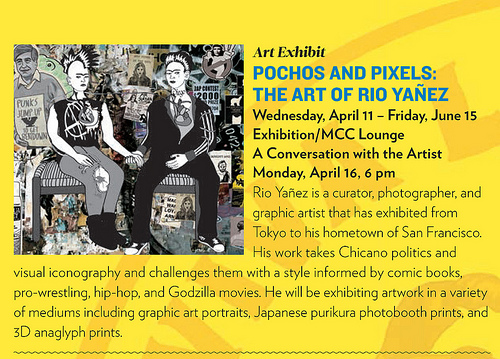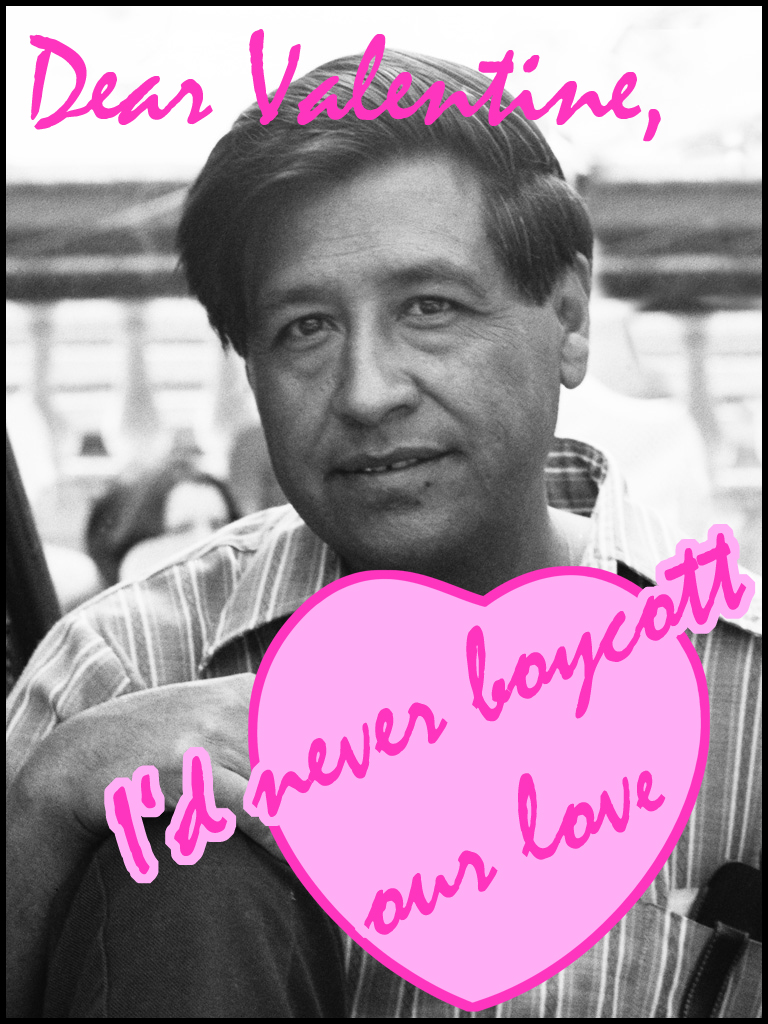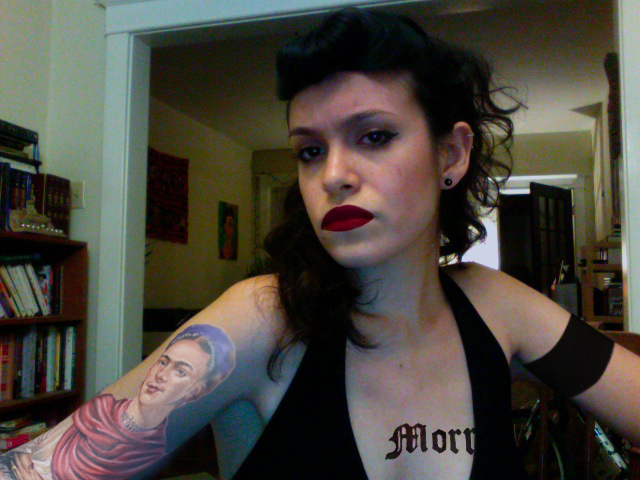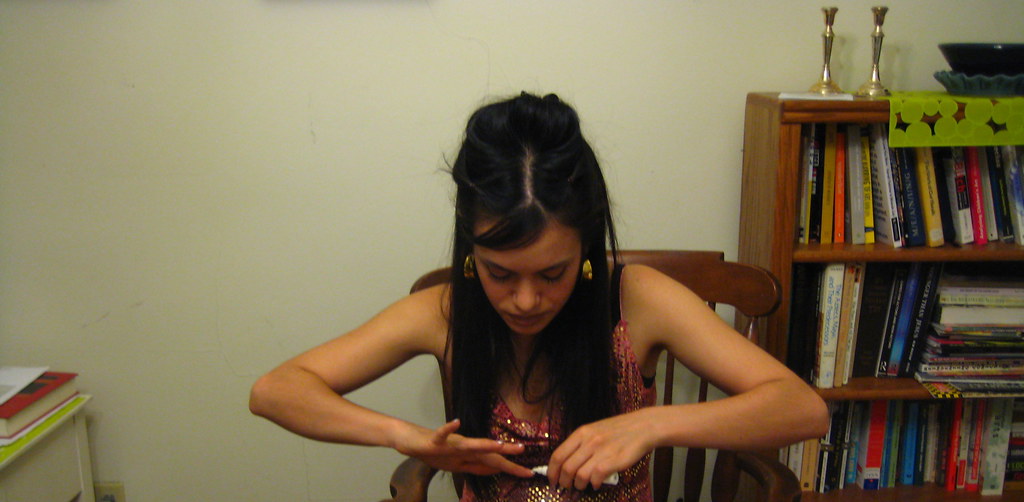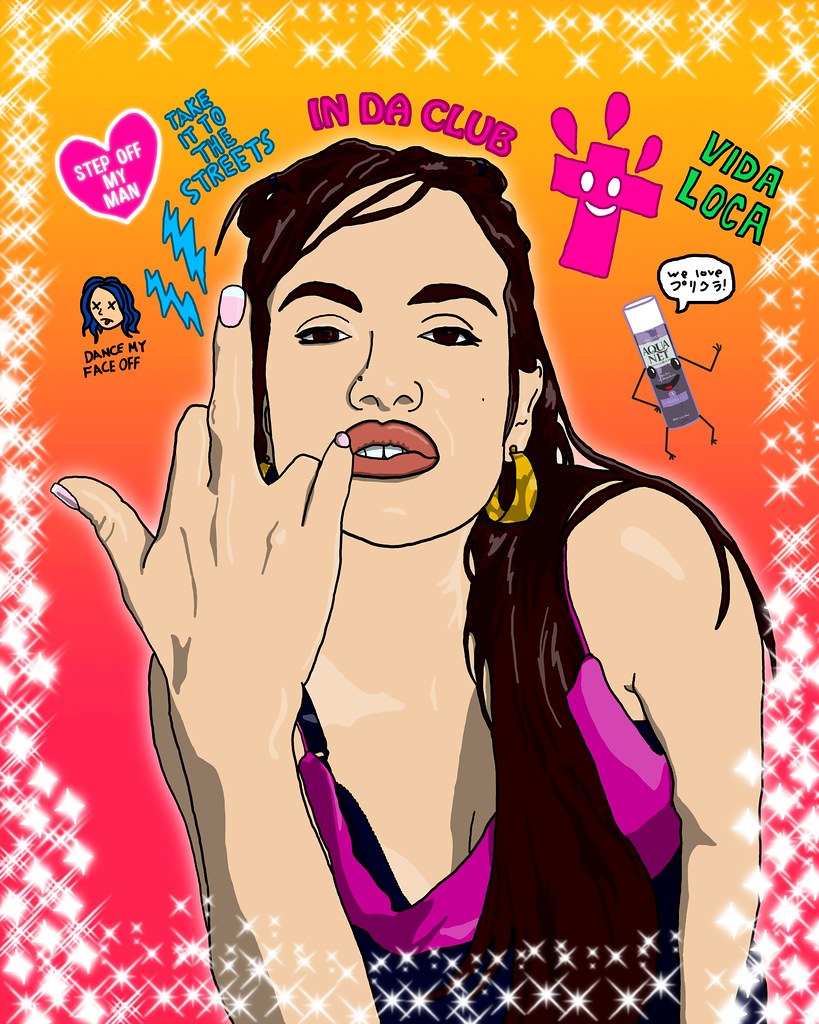Rio Yañez never ceases to amaze me... This time it's through his (FIRST!!!) solo exhibition, Pochos and Pixels: The Art of Rio Yañez. Just look at this dual punk rock meets hip hop (ghetto) Frida... Clearly, Rio is an artistic mastermind. WHAT: Pochos and Pixels: The Art of Rio Yañez.WHEN: Wednesday, April 11 – Friday, June 15 2012Monday-Friday: 8:00AM – 10:00PM,WHERE: UCSB Multicultural CenterUniversity Center room 1504Santa Barbara, CA 93106-6050
WHAT: Pochos and Pixels: The Art of Rio Yañez.WHEN: Wednesday, April 11 – Friday, June 15 2012Monday-Friday: 8:00AM – 10:00PM,WHERE: UCSB Multicultural CenterUniversity Center room 1504Santa Barbara, CA 93106-6050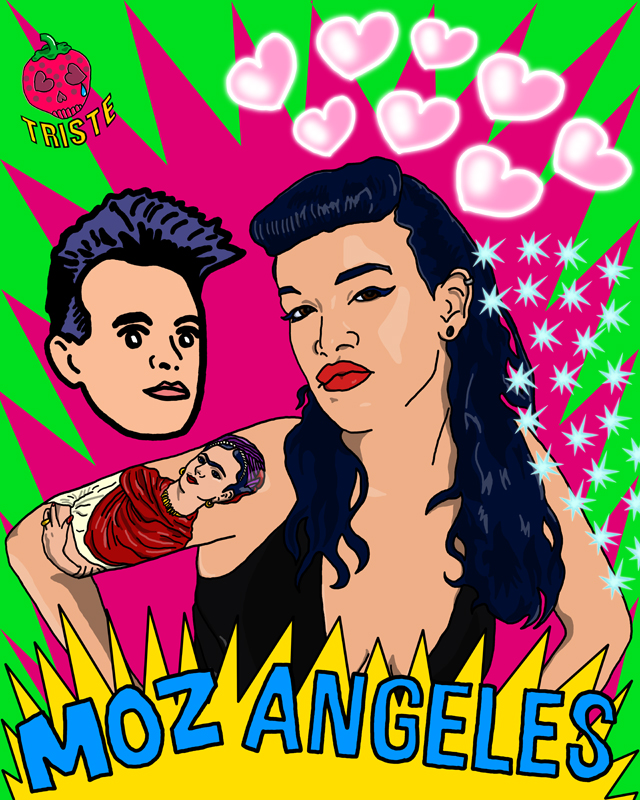

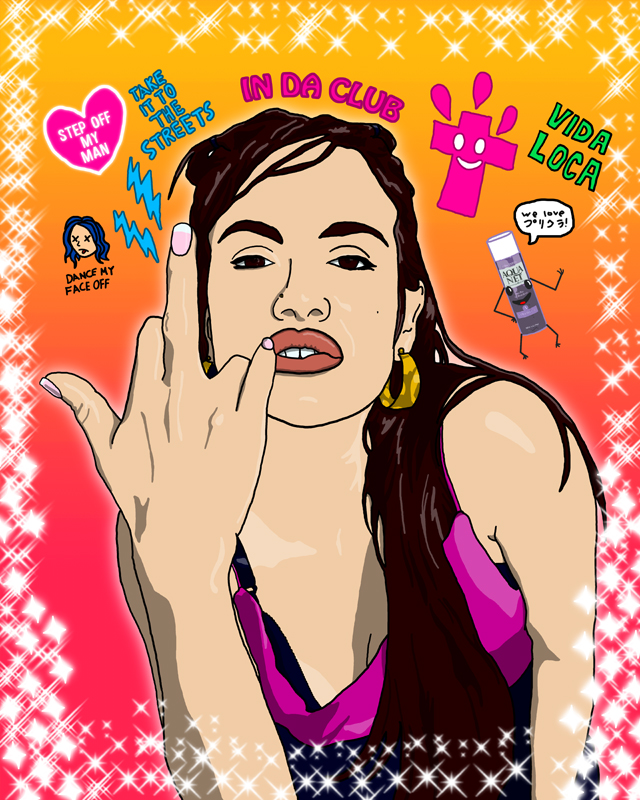 Acciones Plásticas プリクラ collaboration with Rio Yañez (2009)
Acciones Plásticas プリクラ collaboration with Rio Yañez (2009)
Why did you have to pick this weekend to be a Chicano?
 Mayra Ramirez makes my heart pitter patter....(here is a repost of one of her latest posts on her blog Hella Breezys)
Mayra Ramirez makes my heart pitter patter....(here is a repost of one of her latest posts on her blog Hella Breezys)
It's hard for me to fully express my disappointment and frustration with Arizona's law makers... last week they passed HB 2281 witch bans "Ethnic Studies" in the states K-12 grade classrooms. I cannot emphasize how important it is to be able to learn about the history of our peoples, of our ancestors, and to be able to find pride and empowerment in that. It's such a sad and scary time in both Arizona and the country. Here is a great article about HB 2281 that I found very interesting...
So now I want to share my favorite Save by the Bell episode where Slater finds his Chicano Power!!! I feel it's a great example of why having Ethnic Studies in our classrooms is so crucial...
FUCK ARIZONA'S ETHNOCENTRIC LAWS... WE NEED TO FIGHT FOR THE RIGHT TO LEARN OUR HISTORY, OUR CULTURE AND THE ACCOMPLISHMENTS OF OUR RAZA... TIERRA, JUSTICIA, Y LIBERTAD!!!
RIGHT ON MAYRA!!![youtube=http://www.youtube.com/watch?v=T0wvG3RMKPc][youtube=http://www.youtube.com/watch?v=Ih1Qmq5Ie5k]And be sure to check out her collaboration with the always amazing Rio Yañez
belated valentines day love from el rio
Sorry for the delay in this post. I have been in Chicago tied up with CAA, so much so, that the lovely Hallmark holiday of love, almost slipped through my fingers. But have no fear, I am back with full force, presenting my now frequent colllaborator Rio Yañez's pop culture, commodified, chicano, arty valentines amazingness.
From his El Rio flickr page:
What’s up to all my friends, lovers, and drunken makeout partners! El Rio’s Valentine’s Day Cards are back in the ring to take another swing for 2010! This is the 4th year of my cards and it's turned into my longest running project. Enjoy!
As always, please post these cards on the pages of your friends, enemies, sexting partners, craigslist hookups, and friends with benefits.
Stimulus, 2010
Sotomayor, 2010
Supa Freaks, 2008
El Rio's Valentine's Day Cards # 2, 2007
Moz Lov, 2009
behind the scenes acciones plásticas purikura
Here are some behind the scenes images from the many Acciones Plásticas プリクラ photo shoots.
The Latina Hipster
The Homegirl
The Homegirl putting on fake nails (lovin' the shabbos candlesticks and theory books in the background)
The Avodah Girl
The 612er
---------------------------------------------------------
Check out this inspiring write-up on Acciones Plásticas プリクラ on Truth and Healing Project.excerpt below:
goodness. I’ve been thinking a lot about the intersections between new media and traditional forms of knowledge and how these intersections can be ways of supporting tradition, innovation, resistance and liberation. As a media-maker, I’ve thought a lot about non-traditional forms of telling stories and the value of stories to allow us as individuals and communities to grow and remain in movement. I want to both honor our traditions and create space for challenge in order to support growth. This is particularly challenging when, as indigenos, we are usually FORCED into the frozen stance (as my sister Whisper says) of the “American Imaginary”. Born out of a flat analysis, the “American Imaginary” boxes us into specific archetypes and narratives that, though perhaps grounded in truth, metaphorically and at times literally “freeze” us and immobilize us from engaging in healthy movement and LIFE. As a guatemalan-born/ mixed -id’d/ mayan-adoptee I’ve dreamed about new and innovative ways to create forums and craft form that embodies the intersections of say, mayan id, transracial queer, working class, single teen mama id. For example, as a queerasfuck femme I’ve LITERALLY dreamed of beginning a series of corsets created out of huipil’s with stories attached to each… though I have yet to begin work on that. I am so excited by the thoughts of spaces for dialogue, beauty, challenge & examination of the COMPLEX identities embodies by the our contemporary indigena communities. . Fierce and phenomenal chicana and radical latina artists have had HUGE impacts on me but I’ve been hungry to see this come from other guatemelan/ mayan artists. Today, I got a taste of a contemporary and GUATEMALAN artist who is actively engaged in a similar examination! I came across this blog (and art work) and it was as if an answer was given to me in the form of possibilities. A sweet affirmation that this form of mayan/guatemalan art CAN and DOES exist.
acciones plásticas goes プリクラ chicano style
Acciones Plásticas プリクラ
Acciones Plásticas プリクラ is a collaboration between artists Maya Escobar and Rio Yañez.
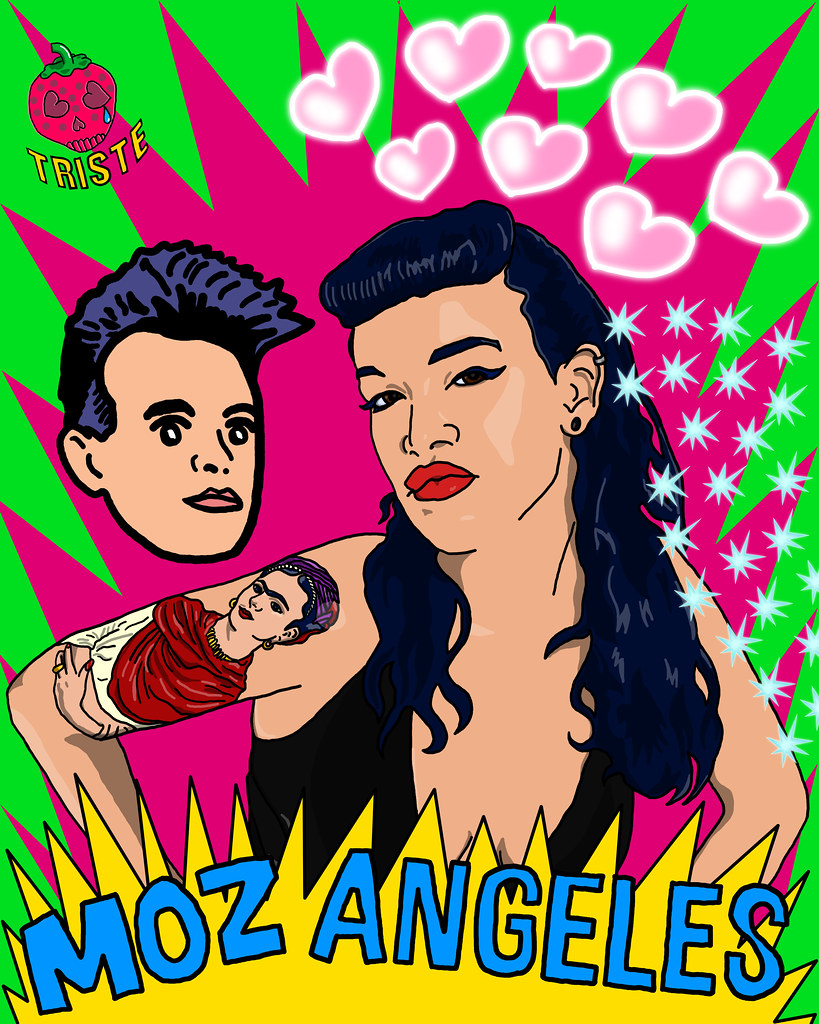 The Latina Hipstera bad-ass Morrissey-lovin’, tuff-girl sexy chica
The Latina Hipstera bad-ass Morrissey-lovin’, tuff-girl sexy chica The Latina Role Modela diploma totin’ intellectual, sexy, social media goddess
The Latina Role Modela diploma totin’ intellectual, sexy, social media goddess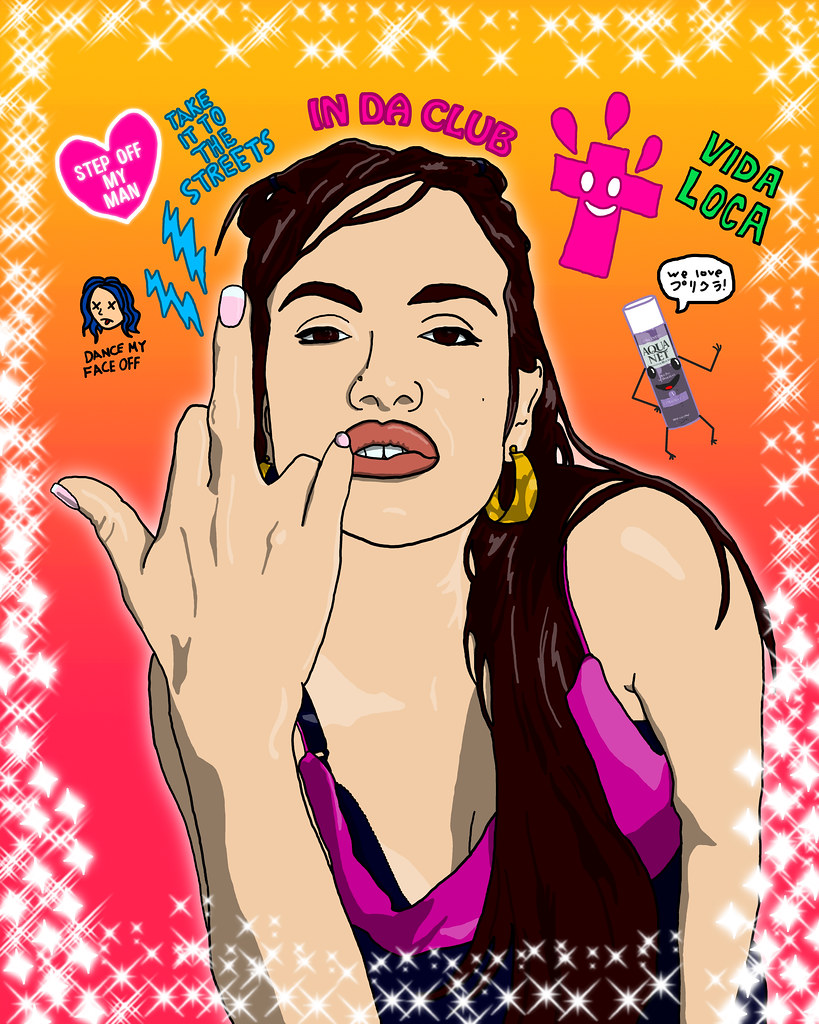 The Homegirla hybridized version of Escobar’s Midwestern Chach and Yañez’s West Coast Chola.In Acciones Plásticas Escobar created a multi-faceted “doll” by assuming the role of designer and distributor, and even posing as the actual doll itself. Each doll was a satirical characterization of some of the many roles that have been projected upon her, and into which she has, at points, inevitably fallen. In conjunction with these images, she developed a short series of low-definition youtube video blogs through which she inhabits the lives of “real women” who have each been visibly defined by societal constructs.Recently, Yañez has been utilizing Japanese photobooths (known as Purikura or “print-club”) as an artist’s tool for creating portraits. These booths are much more common in Japan than their United States counterparts. As a catalyst for creative expression and social interaction they are used primarily by young urban Japanese girls. A standard feature in all Purikura booths allows the user to digitally decorate their portraits after they take them. The options are vast and include wild characters, excessive starbursts of light, pre-made phrases and the option to draw your own text directly on the image. Purikura gives the subjects near-divine powers of self-expression in crafting their own portraits.The two artists who met over the web, decided to bring together Escobar’s highly charged and evocative Acciones Plásticas characters with Yanez’s notorious Chicano graphic-art style and new found obsession with Purikura images, as a way of addressing the construction of Latina identities.Maya posed as The Latina Hipster: a bad-ass Morrissey-lovin’, tuff-girl sexy chica; The Latina Role Model: a diploma totin’ intellectual, sexy, social media goddess; and finally, The Homegirl: a hybridized version of Escobar’s Midwestern Chach (or Chachi Mama) and Yañez’s West Coast Chola. Maya sent digital images to Rio, who in turn drew portraits of her as each of these constructed identities. He approached each portrait with a Purikura sensibility and decorated them each as the characters represented might accessorize themselves. The final series of portraits is the result of negotiating multiple identities and influences. Guatemalan, Jewish, and Chicano sensibilities reflected back through a Japanese Purikura aesthetic. Acciones Plásticas プリクラ challenge and question the thin line between archetype and stereotype. The Purikura elements present the novel signifiers of each social construct represented in the series.This collaboration is the first of many to come as Maya and Rio explore the commonalities and differences of their cultural identities.For more information on Acciones Plásticas プリクラcheck out Rio's blog and stay tuned for guest post by seeNoga aka Carianne Noga on meeting the Chach Homegirl in real life.(video of the Chach featured below)[youtube=http://www.youtube.com/watch?v=Xj3Q42YF40Y]
The Homegirla hybridized version of Escobar’s Midwestern Chach and Yañez’s West Coast Chola.In Acciones Plásticas Escobar created a multi-faceted “doll” by assuming the role of designer and distributor, and even posing as the actual doll itself. Each doll was a satirical characterization of some of the many roles that have been projected upon her, and into which she has, at points, inevitably fallen. In conjunction with these images, she developed a short series of low-definition youtube video blogs through which she inhabits the lives of “real women” who have each been visibly defined by societal constructs.Recently, Yañez has been utilizing Japanese photobooths (known as Purikura or “print-club”) as an artist’s tool for creating portraits. These booths are much more common in Japan than their United States counterparts. As a catalyst for creative expression and social interaction they are used primarily by young urban Japanese girls. A standard feature in all Purikura booths allows the user to digitally decorate their portraits after they take them. The options are vast and include wild characters, excessive starbursts of light, pre-made phrases and the option to draw your own text directly on the image. Purikura gives the subjects near-divine powers of self-expression in crafting their own portraits.The two artists who met over the web, decided to bring together Escobar’s highly charged and evocative Acciones Plásticas characters with Yanez’s notorious Chicano graphic-art style and new found obsession with Purikura images, as a way of addressing the construction of Latina identities.Maya posed as The Latina Hipster: a bad-ass Morrissey-lovin’, tuff-girl sexy chica; The Latina Role Model: a diploma totin’ intellectual, sexy, social media goddess; and finally, The Homegirl: a hybridized version of Escobar’s Midwestern Chach (or Chachi Mama) and Yañez’s West Coast Chola. Maya sent digital images to Rio, who in turn drew portraits of her as each of these constructed identities. He approached each portrait with a Purikura sensibility and decorated them each as the characters represented might accessorize themselves. The final series of portraits is the result of negotiating multiple identities and influences. Guatemalan, Jewish, and Chicano sensibilities reflected back through a Japanese Purikura aesthetic. Acciones Plásticas プリクラ challenge and question the thin line between archetype and stereotype. The Purikura elements present the novel signifiers of each social construct represented in the series.This collaboration is the first of many to come as Maya and Rio explore the commonalities and differences of their cultural identities.For more information on Acciones Plásticas プリクラcheck out Rio's blog and stay tuned for guest post by seeNoga aka Carianne Noga on meeting the Chach Homegirl in real life.(video of the Chach featured below)[youtube=http://www.youtube.com/watch?v=Xj3Q42YF40Y]
Nuevos Compañeros: Rio Yañez
My newest partner in crime is the talented, witty, godzilla and pikapika lovin' Chicano artist and curator Rio Yañez. I first came across his Ghetto Frida two years ago, while working on the project Obsessed With Frida Kahlo. Immediately I felt some sort of cosmic connection-not to Ghetto Frida- but to her creator. And then to make matters worse better, I found out that he is the son of one my biggest heroes- Yolanda Lopez!There was really no option other than collaboration. It was fate.Last month we finally initiated our long distance partnership through a tweet. Since then we have been communicating through TwitPic, Facebook, YouTube, phone calls and texts, and of course mutual shouts in interviews on the blogosphere (mine to Rio & Rio's to me.)Here are a few examples of Rio's recent work:
"I’ve been twittering for about a week now at http://twitter.com/rioyanez. I signed up as a way to contact Amber Rose after she started writing and posting about the portrait I created of her. I have to say, the most exciting aspect of twitter is the way people distribute images. The short urls for twitpics that often pop up on tweets evoke a sense of curiosity in me; more so than the many thumbnails that can be found on facebook. I think the lack of a thumbnail is more alluring and it forces you to chose to see the image or not, there’s no middle ground of a provided preview." (from his blog)
"Artist Curator Rachel-Anne Palacios flanked by Zitlalix and I. I created this portrait to thank Rachel for including me in the recent Frida exhibit she curated and to join the many artists who are on display on the walls of her apartment" (from flickr)
These images represent my first foray into my Raza Zombies series. They were inspired by the single best mainstream comic book of the 21st century: Marvel Zombies. Marvel Zombies re-imagines classic superheroes as flesh eating zombies. After reading it I felt compelled to do some zombie transformations on a few of my own personal heroes. More to come. (from flickr)[youtube=http://www.youtube.com/watch?v=1AhRQrJ7ePg]
Video of Gomez Peña setting the record straight for Rio regarding his Facebook presence.
[youtube=http://www.youtube.com/watch?v=QycIf6uKRd0]
Rio's Ghetto Frida Mural in the Mission District
stay tuned for more...
Identity Issues Affecting Puerto Rican Girls: An Artist Speaks
In her essay The Myth of the Latina Woman/ Just Met a Girl Named Maria, Judith Ortiz Cofer describes her Puerto Rican upbringing in a strict Catholic home in New Jersey, where she was taught to behave like a proper señorita. Cofer explains that the conflicting messages she received as a child, were those commonly propagated by Puerto Rican mothers. “They encourage their daughters to look and act like women and to dress in clothes that our Anglo friends and their mothers found to mature for our age.”When the mere notion of latinidad equates passion and sexuality to gringos, why is it that Latino men are the first ones to point finger and to call these same women suelta (loose) or facil (easy)? Wouldn’t they understand? Have they not been subjected to the same treatment? Perhaps it is comes down to the way they were raised.In the Latino culture ideas of masculinity and femininity are delineated very early on. Author Evelyn P. Stevens, first introduced this concept know as machismo and marianismo in 1973. Machismo grants supreme authority of the man over the woman. Under this doctrine women, who are considered to be morally and spiritually superior to men are able to endure abuse. They grow up expected to follow the sexual code of marianismo, and are submissive to the man’s authority.Puerto Rican culture places women into one of two categories the virgin or the whore; mujeres de la casa (women of the home) or mujeres de la calle (women of the street). Una mujer de la casa, is expected to be pure, giving and compassionate. While, una mujer de la calle is considered to be sluty, wild, and dangerous.In Honor and the American Dream: Culture and Identity in a Chicano Community, author Ruth Horowitz says the following:The very presence of a woman outside the household implicates them in promiscuity and/or sexual misconduct. Puerto Rican girls learn this good girl/bad girl dichotomy most clearly in the recruitment into reproductive labor… A good girl cooks, cleans, takes care of younger siblings, and helps her parents. In contrast una muchacha de la calle is a transgressive women who has gone beyond patriarchal control whose sexuality is unbounded and therefore dangerous.While in Puerto Rico this January, I had the privilege of meeting the incredibly talented video artist, Tamara Liz Rivera Boria. Tamara and I instantly bonded, finding similarity in the content of our work, and decided that we needed to collaborate.I conducted a short series of interviews with her (documented with the camera from my laptop), where she describes her work as it plays on the screen behind her…[youtube=http://www.youtube.com/watch?v=I2SdDl2zaus] click on above image to view videoInterview with Puerto Rican Artist Tamara Liz Rivera BoriaMaya: Tamara, what can you tell me about muchachas de la calle and muchachas de las casa?Tamara: De la casa and de la calle girls might as well be related. They exchange roles sometimes, de la casa girl wanting to be de la calle, and vice versa.Maya: How has this affected you?Tamara: I was raised in a catholic home, in a catholic school. I can tell you, I have been fucked up. I didn’t want to be told what to do, or what to believe in.How can you tell someone that using a condom is a sin? I had many issues over the years being raised like that. Even though my parents are not Catholic extremists. They were pretty easy going that’s how they could understand me or deal with me. Deep inside it made a mark, no matter how much I tried to live and understand the world. I became insane trying to understand other people lifestyle because indeed I might have been raised inside a bubble. I still am kind of in there, don’t wanting to look at how things really are.Maya: What role does your cultural upbringing play in your work?Tamara: Recently I made a video called él, baño de marîa. In this video I present various symbolism about religion, pecados (sins), sexuality, purity, faith among other things. Mainly because our culture has raised us thinking inside the box, controlling us with Christianity, especially Catholicism. Being pure, waiting till marriage although most don’t do it, is deep inside the mind. Like it is wrong to embrace sexuality.Aglubium, is another video I made in collaboration with Ralph Vazquez and Rebecca Adorno. In this video I am drowning, or trying to kill myself by submerging my head in the water. It’s aggressive, and it’s beautiful. We just want to end, we don’t want to think. We don’t want to face fears. We don’t want to wait, we want to get it over. We want to drown our fears. We don’t want to face reality. Escape its what we do.Maya: How do you escape?Tamara: Most people (Puerto Ricans) use drugs. Puerto Ricans that do not use illegal drugs, use legal pills, alcohol or even coffee. Everyone has an addiction. It’s a shame but I have seen most of my friends doing drugs. I been there, I done that but I never had an addiction. My new boyfriend said I was an alcoholic, he didn’t believe me when I said I wasn’t. It wasn’t till he lived with me for over a moth when he saw that I didn’t drink for so long that he believed me, and with the cigarettes the same.For some weird reason I can try things for as long as I want and not create any addiction. I wish it were the same with those that surround me. But in the arts almost all the people I know use some kind of drugs, are the ones that worry me the most are the most intelligent that keep using. I guess they are not that smart…Maya: Is there an alternative to escape?Tamara: I can see clearly that with true art I can make a difference, I can say what I understand to be real and important. I might help somebody. Other people just ignore what is going on (Puerto Rico). So many things had happen here, that demanded the people marching up the streets in protest, because our government is insane. But people don’t, they just “sit quietly”. They don’t want to get involved, they think they cannot change anything. They believe they have no power, when indeed I say, with all your power, what would you do? – I love that flaming lips song-Maya: How does this affect Puerto Rican girls?Tamara: Puerto Rican girls have many issues. Not only because of gringos (Americans) our identity issues extend into religion and the ways women are portrayed in the reggaeton culture. Girls want to be thin like gringas (American girls), they don’t like they’re beautiful curves, ass and tits. They always feel fat no matter how thin they are. I bet this happen everywhere, but these are issues we shouldn’t have.Accepting ourselves, as we are its what we should do. Because we are not gringas! We are not blonde and white! But boys see these girls in TV, and everywhere and they expect girls like that. It’s the gringo media. I’ve forgotten all about this, but I also had these issues. I think I kind of still do, I just ignore most of the time.Maya: You mentioned Reggaeton, what message do you think Reggaeton is sending to young women?Tamara: Reggaeton is a part of that movement leads ladies to feeling less than the man, like he has to buy her. Girls learn to use their sexual power way to early with reggaeton. It is a confrontation for some, between what they like (reggaeton movement, lifestyle) and the religious foundation they might have. But since it probably was forced (religion) they escaped thru reggaeton. Ultimately ending in ugly situations.Maya: Okay , I agree with you. But I am not going to lie, I love reggaeton… are you sure you don’t secretly like it?Tamara: I don’t dig reggaeton; I see how girls embrace being just a piece of meat, especially high schools girls. How much is this necklace, like a million? Said a girl, the boy answered – no. The girl said - well then, work and buy me this necklace.Yesterday I heard a senior girl say that to her boyfriend at a hotel, it was their prom. Girls parade in lil’ dresses, easily they could have been mistaken for high-class whores. I won’t even comment on the dancing. It has gotten worse, every time. Since parents are so young they allow they’re children to behave like this. I mean, I see a problem with these situations. Boys catch another boy,looking at their girls, no matter if its sexual or if they just passed and look because its simply there, they get all worked up and want to fight. What is that dumbass looking at? So basically, what, people cant look at each other now? Girls can’t stand if you look at them either. Puerto Rico was not like that; you went to the mall, smiled and people smiled back at you.The reggaeton anger and sexual damage can be easily identified. Even kindergarten boys are sexually harassing little girls. My mom is a teacher and I have heard some stories. I haven’t analyzed reggaeton issues deeply; this is just for what I have seen.Maya: Thank you for your insight Tamara, I can’t wait to see what you produce next. I hope we can collaborate together in the future.Tamara: I know I could make more sense out of my ideas, since they’re not organized very well, but it doesn’t matter. This is just the beginning of many wonderful works to come, ideas to flow… I’m glad that I can collaborate with you.
click on above image to view videoInterview with Puerto Rican Artist Tamara Liz Rivera BoriaMaya: Tamara, what can you tell me about muchachas de la calle and muchachas de las casa?Tamara: De la casa and de la calle girls might as well be related. They exchange roles sometimes, de la casa girl wanting to be de la calle, and vice versa.Maya: How has this affected you?Tamara: I was raised in a catholic home, in a catholic school. I can tell you, I have been fucked up. I didn’t want to be told what to do, or what to believe in.How can you tell someone that using a condom is a sin? I had many issues over the years being raised like that. Even though my parents are not Catholic extremists. They were pretty easy going that’s how they could understand me or deal with me. Deep inside it made a mark, no matter how much I tried to live and understand the world. I became insane trying to understand other people lifestyle because indeed I might have been raised inside a bubble. I still am kind of in there, don’t wanting to look at how things really are.Maya: What role does your cultural upbringing play in your work?Tamara: Recently I made a video called él, baño de marîa. In this video I present various symbolism about religion, pecados (sins), sexuality, purity, faith among other things. Mainly because our culture has raised us thinking inside the box, controlling us with Christianity, especially Catholicism. Being pure, waiting till marriage although most don’t do it, is deep inside the mind. Like it is wrong to embrace sexuality.Aglubium, is another video I made in collaboration with Ralph Vazquez and Rebecca Adorno. In this video I am drowning, or trying to kill myself by submerging my head in the water. It’s aggressive, and it’s beautiful. We just want to end, we don’t want to think. We don’t want to face fears. We don’t want to wait, we want to get it over. We want to drown our fears. We don’t want to face reality. Escape its what we do.Maya: How do you escape?Tamara: Most people (Puerto Ricans) use drugs. Puerto Ricans that do not use illegal drugs, use legal pills, alcohol or even coffee. Everyone has an addiction. It’s a shame but I have seen most of my friends doing drugs. I been there, I done that but I never had an addiction. My new boyfriend said I was an alcoholic, he didn’t believe me when I said I wasn’t. It wasn’t till he lived with me for over a moth when he saw that I didn’t drink for so long that he believed me, and with the cigarettes the same.For some weird reason I can try things for as long as I want and not create any addiction. I wish it were the same with those that surround me. But in the arts almost all the people I know use some kind of drugs, are the ones that worry me the most are the most intelligent that keep using. I guess they are not that smart…Maya: Is there an alternative to escape?Tamara: I can see clearly that with true art I can make a difference, I can say what I understand to be real and important. I might help somebody. Other people just ignore what is going on (Puerto Rico). So many things had happen here, that demanded the people marching up the streets in protest, because our government is insane. But people don’t, they just “sit quietly”. They don’t want to get involved, they think they cannot change anything. They believe they have no power, when indeed I say, with all your power, what would you do? – I love that flaming lips song-Maya: How does this affect Puerto Rican girls?Tamara: Puerto Rican girls have many issues. Not only because of gringos (Americans) our identity issues extend into religion and the ways women are portrayed in the reggaeton culture. Girls want to be thin like gringas (American girls), they don’t like they’re beautiful curves, ass and tits. They always feel fat no matter how thin they are. I bet this happen everywhere, but these are issues we shouldn’t have.Accepting ourselves, as we are its what we should do. Because we are not gringas! We are not blonde and white! But boys see these girls in TV, and everywhere and they expect girls like that. It’s the gringo media. I’ve forgotten all about this, but I also had these issues. I think I kind of still do, I just ignore most of the time.Maya: You mentioned Reggaeton, what message do you think Reggaeton is sending to young women?Tamara: Reggaeton is a part of that movement leads ladies to feeling less than the man, like he has to buy her. Girls learn to use their sexual power way to early with reggaeton. It is a confrontation for some, between what they like (reggaeton movement, lifestyle) and the religious foundation they might have. But since it probably was forced (religion) they escaped thru reggaeton. Ultimately ending in ugly situations.Maya: Okay , I agree with you. But I am not going to lie, I love reggaeton… are you sure you don’t secretly like it?Tamara: I don’t dig reggaeton; I see how girls embrace being just a piece of meat, especially high schools girls. How much is this necklace, like a million? Said a girl, the boy answered – no. The girl said - well then, work and buy me this necklace.Yesterday I heard a senior girl say that to her boyfriend at a hotel, it was their prom. Girls parade in lil’ dresses, easily they could have been mistaken for high-class whores. I won’t even comment on the dancing. It has gotten worse, every time. Since parents are so young they allow they’re children to behave like this. I mean, I see a problem with these situations. Boys catch another boy,looking at their girls, no matter if its sexual or if they just passed and look because its simply there, they get all worked up and want to fight. What is that dumbass looking at? So basically, what, people cant look at each other now? Girls can’t stand if you look at them either. Puerto Rico was not like that; you went to the mall, smiled and people smiled back at you.The reggaeton anger and sexual damage can be easily identified. Even kindergarten boys are sexually harassing little girls. My mom is a teacher and I have heard some stories. I haven’t analyzed reggaeton issues deeply; this is just for what I have seen.Maya: Thank you for your insight Tamara, I can’t wait to see what you produce next. I hope we can collaborate together in the future.Tamara: I know I could make more sense out of my ideas, since they’re not organized very well, but it doesn’t matter. This is just the beginning of many wonderful works to come, ideas to flow… I’m glad that I can collaborate with you.
“Everything that surrounds me, mi entorno, makes a part of who I am and what I say in my videos. Little by little its somehow implicated.”
As I begrudgingly stated in my interview with Tamara, I am a fan of reggaeton. Like most, I don’t even acknowledge the lyrics or really think too much beyond the beat of the music. Yet now I find myself wondering, are most girls conscious of the message? I guess to some extent they must be, after all as Tamara shared many sing the lyrics as they grind (rub up) on men.In my research I found extensive commentary regarding the direction of Salsa and its implications on women in the Puerto Rican community. However, as it is relatively new form of music, the writing concerning Reggaeton seems to be incredibly limited.So I turned to a more contemporary source and found a blog entitled REGGAETONICA, written by Raquel Z. Rivera; author of New York Ricans from the Hip Hop Zone. In a recent post: From White to Mulata: The Darkening Powers of Reggaetón, she shares an email addressing this very issue:
I think reggaeton has been raunchy & explicitly all along, but I think the lyrics have reverted back to the "Reggeaton Sex" days of Underground. I think that "raunchiness" & degradation have become more mainstream & therefore are seen as less scandalous & more acceptable to society, so I think it has questioned our value as a community. The fact that Reggaeton outright refers to sexual references & acts & is accepted as mainstream Puerto Rican culture posing an interesting cultural issue for me. Now you can go to Puerto Rico and see young girls singing "dame con el palo, " & they're parents paying no mind to it, which I think is crazy. In the beginning of Reggaeton I found the lyrics to be much more raunchy, violent, & drug-related. Then mainstream Reggaeton came along, switched the "sexo" to "amor" & the "nenas" to "gatas." I think these subtle changes in language allowed Reggaeton to be more successful in the mainstream, but now a lot of artists are moving back to the original lyrics because they already have a stable fan base. I mean, look at someone like Tony Dize, if you translated some of his songs into English, they could put even 50 Cent to shame with the blatant sexual references & degradation of women.
Perhaps reggaeton is so widely accepted by mainstream and popular culture, because it provides a free ticket to promote these concepts in a non-threatening form. If Puerto Rican women and other Latinas are fine dancing to this music, then what harm is there in gringos doing the same.This then becomes representative of Puerto Rican culture. When a gringa dances to reggaeton she can purse her lips and grind on men, but without an attached stigma. She is just acting like a Latina girl. The Puerto Rican girls participating in this scene are aiding in the further perpetuation of the stereotype of Latina’s being easy.However, as Tamara explained a lot of this has to do with a search for independence. Wanting to rebel against the forced restrictions of being una mucha de la casa, girls go to the furthest extreme to break down those barriers. But to what cost?I myself am unable to provide a concrete solution. Yet I do think that one of the primary steps to forward progress is conversation. Tamara and myself have opted to publish the text on the web so that others may join in the dialog…[youtube=http://www.youtube.com/watch?v=rxiWzxItuzo]
